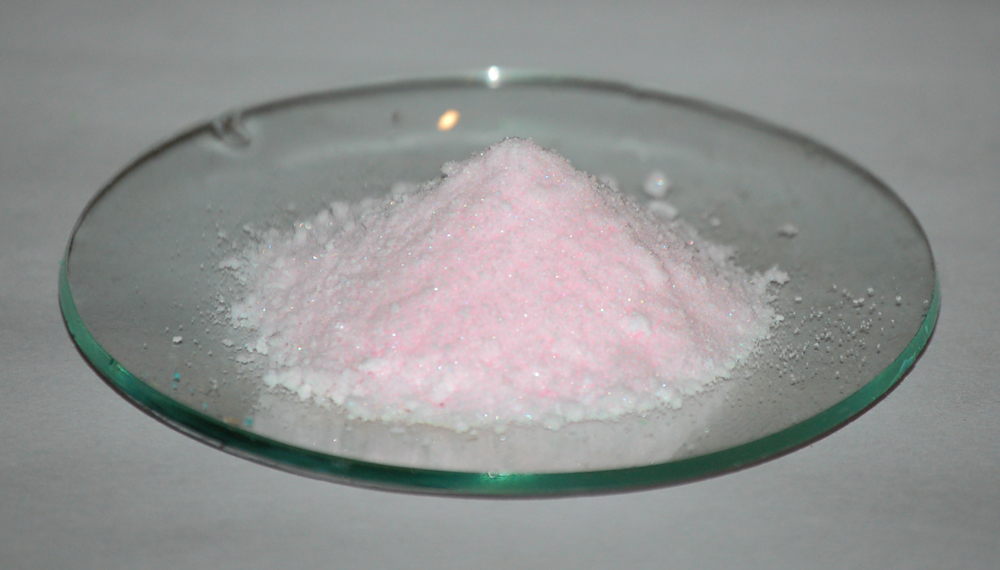Manganese (II) sulfate or manganese sulfate is an inorganic salt of sulfuric acid and manganese, which has an oxidation state of 2+. It is also sometimes called manganese sulfate. The chemical formula of manganese sulfate is MnSO 4 . In nature, it occurs in the form of crystalline hydrates in some minerals: smiquit (monohydrate), ilezite (tetrahydrate), jococuit (pentahydrate), mullardite (heptahydrate).
Getting
This salt is obtained by dissolving manganese (II) oxide or manganese carbonate in sulfuric acid.
MnO + H 2 SO 4 = MnSO 4 + H 2 O
MnCO 3 + H 2 SO 4 = MnSO 4 + H 2 O + CO 2
Manganese oxide is a fairly common raw material, so almost all manganese sulfate is obtained in this way.
It can be obtained by leaching the reduced ore with ammonium sulfate. It is also a by-product of the processing of manganese carbonate ores.
Physical properties
Manganese sulfate is a colorless crystalline powder. Its solutions have a slightly pink hue, due to the formation of an aquacomplex with manganese [Mn (H 2 O) 6 ] 2+ . Easily soluble in water, very slightly in alcohols and ethylene glycol. Maximum solubility is achieved at 25 ° C. The melting point is 700 ° C; at 850 ° C it decomposes into sulfur and manganese oxides. The density of the crystals at 20 ° C is 3.25 g / cm 3 . It is a paramagnet, i.e. magnetized in an external magnetic field.

It can absorb water, forming crystalline hydrates with 1,4,5 or 7 molecules of water. These crystalline hydrates are pink in color and have slightly different physical properties from anhydrous manganese sulfate. Each of them has its own temperature range in which it will be most stable: monohydrate - only above 200 ° C, tetrahydrate - at 30-40 ° C, pentahydrate - 9-25 ° C, heptahydrate - only below 9 ° C. Almost all of these crystalline hydrates erode in air (lose water and are destroyed), except for tetrahydrate.
Chemical properties
Since manganese in this salt has a lower oxidation state (+2), this salt can be a reducing agent and interact with strong oxidizing agents:
2MnSO 4 + 8HNO 3 + 5PbO 2 = 2HMnO 4 + 4Pb (NO 3 ) 2 + Pb (HSO 4 ) 2 + 2H 2 O
Interacts with alkalis, with precipitation:
MnSO 4 + 2KOH = Mn (OH) 2 ↓ + K 2 SO 4
By electrolysis of a solution of manganese sulfate, it is possible to obtain metallic manganese:
2MnSO 4 + 2H 2 O = 2Mn ↓ + O 2 + 2H 2 SO 4
Application
In chemical production, this salt is used to obtain pure manganese and its other compounds. It is also used as an analytical reagent. In the food industry and pharmaceuticals, it is a biologically active additive (both for humans and animals). It is also a catalyst in organic synthesis. Detailed technical data on this substance are available in various GOSTs. Manganese sulfate is used in the textile industry as a component of dyes for fabrics and porcelain.
The main use of manganese sulfate is fertilizers. Manganese and sulfur are important elements for plant growth, and in this compound they are in a form very accessible to them, because manganese sulfate is highly soluble in water.
More on fertilizer use
This fertilizer can be applied to almost all plants and on any soil. Sandy and forest soils necessarily need to use this fertilizer. It is worthwhile to carefully increase the concentration of manganese on chernozems in order to prevent an excess of this element. This can lead to intoxication of plants and the appearance of spots on the edges of the leaves. But it is worth considering that the acidity of the soil affects the rate of salt dissolution: in acidic soils, manganese sulfate dissolves more slowly, which means it is more slowly absorbed by plants. Therefore, before applying fertilizer, it is advisable to deoxidize the soil with limestone.
Manganese vitriol qualitatively and quantitatively increases crop yields, since manganese increases the chlorophyll content in plants. With its lack, chlorosis, fusarium, brown spotting and brown rust occur: young leaves become too small and spots appear on them, and old ones are pale and yellow between the veins. Such leaves die off quickly, due to which plants are stuck in growth and flowering. Some crops generally cease to bear fruit.
Usually, manganese sulfate is introduced together with nitrogen, phosphorus and potash fertilizers. It increases the ability of plants to absorb other basic nutrients: potassium, nitrogen and phosphorus. It also increases the sugar content in crops. This is especially true for root vegetables, berries and vegetables. Juices that are obtained from such fruits have a low acidity. All this positively affects the shelf life of the fruit.
This fertilizer has another useful property: it is not washed out by sediments, thereby remaining in the soil for a long time. This makes the effect of fertilizer prolonged. When used in greenhouse conditions, it is recommended to apply fertilizer in the form of a solution with a concentration of no higher than 0.2%. It is best to water fertilized plants with water at a temperature of 20-25 ° C, since salt is best dissolved in this interval.
Safety precautions
Manganese sulfate is a toxic substance. Moreover, both anhydrous and its crystalline hydrates. If ingested, it causes severe poisoning, which can seriously damage the nervous and digestive systems, as well as the brain. When it comes into contact with the skin, dermatitis and eczema appear, which are very difficult to treat.
When working with this substance, it is necessary to cover exposed skin, wear rubber gloves and a respirator. The room should be well ventilated or have a ventilation system, as well as constantly checked for the maximum permissible concentration of manganese in the air. Stored manganese sulfate should only be in sealed packaging.